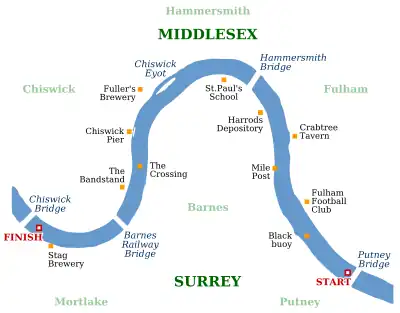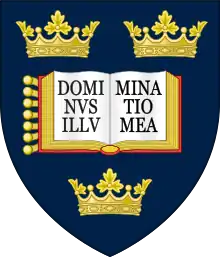The Boat Race 1846
The 8th Boat Race between crews from the University of Oxford and the University of Cambridge took place on the River Thames on 3 April 1846. Umpired by Charles Jasper Selwyn, Cambridge won in a time of 21 minutes 5 seconds, with a winning margin of three lengths. The race was held on the ebb tide, starting in Mortlake and ending in Putney. For the first time, outriggers were used by both crews.
| 8th Boat Race | |||
|---|---|---|---|
| Date | 3 April 1846 | ||
| Winner | Cambridge | ||
| Margin of victory | 3 lengths | ||
| Winning time | 21 minutes 5 seconds | ||
| Overall record (Cambridge–Oxford) | 6–2 | ||
| Umpire | C. J. Selwyn | ||
| |||
Background

The Boat Race is a side-by-side rowing competition between the University of Oxford (sometimes referred to as the "Dark Blues")[1] and the University of Cambridge (sometimes referred to as the "Light Blues").[1] The race was first held in 1829, and since 1845 has taken place on the 4.2-mile (6.8 km) Championship Course on the River Thames in southwest London.[2][3]
Following their ten-length defeat in the previous year's race,[4] Oxford sent their challenge to Cambridge in February 1846, proposing that the race should take place at Easter.[5] The umpire for the race was Charles Jasper Selwyn.[6][7] Cambridge went into the race leading the contest overall, with five wins to Oxford's two since the inaugural race in 1829.[4] On one of only a handful of occasions, the race was rowed on the ebb tide, from Mortlake to Putney.[8]
For the first time in the history of the race, both boats used outriggers.[9] Both crews had professional coaches: Oxford used John Noulton while Cambridge were trained by Robert Coombes, a champion sculler.[10] It marked the start of the debate over the use of professional coaches which was not resolved until the 1852 race.[8]
Crews
The Cambridge crew weighed an average of 11 st 8.375 lb (73.5 kg), 3.25 pounds (1.5 kg) more per rower than their opponents.[11] Oxford saw three Blues return from the 1845 race in Royds, Stapylton and Milman; Harkness and Hill returned for Cambridge.[11]
| Seat | Cambridge |
Oxford | ||||||
|---|---|---|---|---|---|---|---|---|
| Name | College | Weight | Name | College | Weight | |||
| Bow | George Francis Murdoch | Lady Margaret Boat Club | 10 st 2 lb | H. S. Polehampton | Pembroke | 10 st 9 lb | ||
| 2 | George Frederick Holroyd | 1st Trinity | 11 st 1 lb | E. C. Burton | Christ Church | 11 st 0 lb | ||
| 3 | Stephen Thomas Clissold | 3rd Trinity | 12 st 0 lb | W. U. Heygate | Merton | 11 st 8 lb | ||
| 4 | William Pickering Cloves | 1st Trinity | 12 st 12 lb | E. H. Penfold | St John's | 11 st 8 lb | ||
| 5 | Edmond Wilder | Magdalene | 13 st 2 lb | John W. Conant | St John's | 12 st 4 lb | ||
| 6 | Robert Harkness (P) | Lady Margaret Boat Club | 11 st 6 lb | F. C. Royds | Brasenose | 11 st 9 lb | ||
| 7 | Ed. Parker Wolstenholme | 1st Trinity | 11 st 1 lb | W. C. Stapylton | Merton | 10 st 12 lb | ||
| Stroke | Charles Gray Hill | 2nd Trinity | 11 st 1 lb | W. H. Milman (P) | Christ Church | 11 st 0 lb | ||
| Cox | T. B Lloyd | Lady Margaret Boat Club | 9 st 8 lb | C. J. Soanes | St John's | 9 st 13 lb | ||
| Source:[11] (P) – boat club president | ||||||||
Race
At Hammersmith Bridge Cambridge had drawn half a boat's length ahead, but Oxford put on such a desperate spurt and came up as before. But this was their final effort; for pulling with unparalleled pluck and resolution, they had taken it all out of themselves.
The Cambridge Book[12]
Conditions for the race were described by MacMichael as "very fine, and the little wind there was with the tide."[6] The race commenced shortly after 11.10 a.m., started by Edward Searle.[13] Oxford won the toss and elected to start from the Surrey station, handing Cambridge the Middlesex side of the river.[6][14] Despite taking an early lead, Oxford were soon caught and Cambridge drew away, holding a third-of-a-length lead by Chiswick. As the long bend began to favour Oxford, Cambridge slowed in shallow water allowing the Dark Blues to close some of the discrepancy, but by Hammersmith Bridge, Cambridge were back to a half-length lead. A final surge from Oxford once again closed the gap, but Cambridge pulled away to take the victory in a record time of 21 minutes 5 seconds and by a margin of three lengths.[15]
References
Notes
- "Dark Blues aim to punch above their weight". The Observer. 6 April 2003. Archived from the original on 11 September 2014. Retrieved 1 September 2014.
- Smith, Oliver (25 March 2014). "University Boat Race 2014: spectators' guide". The Daily Telegraph. Archived from the original on 1 July 2014. Retrieved 1 September 2014.
- "The Course". The Boat Race Company Limited. Archived from the original on 28 October 2014. Retrieved 1 September 2014.
- "Boat Race – Results". The Boat Race Company Limited. Archived from the original on 12 July 2016. Retrieved 26 October 2014.
- MacMichael, p. 133
- MacMichael, p. 134
- Burnell p. 49
- "Early races". The Boat Race Company Limited. Archived from the original on 7 November 2014. Retrieved 1 September 2014.
- MacMichael pp. 133, 136
- Wigglesworth, Neil (20 February 1992). The Social History of English Rowing. Routledge. p. 64. ISBN 978-0-71-463415-9.
- MacMichael, p. 138
- MacMichael, p. 135
- MacMichael, pp. 134, 137
- Burnell, p. 55
- MacMichael, pp. 134–35
Bibliography
- Burnell, Richard (1979). One Hundred and Fifty Years of the Oxford and Cambridge Boat Race. Precision Press. ISBN 978-0-9500638-7-4.
- Dodd, Christopher (1983). The Oxford & Cambridge Boat Race. Stanley Paul. ISBN 978-0-09-151340-5.
- Drinkwater, G. C.; Sanders, T. R. B. (1929). The University Boat Race – Official Centenary History. Cassell & Company, Ltd.
- MacMichael, William Fisher (1870). The Oxford and Cambridge Boat Races: From A.D. 1829 to 1869. Deighton. p. 37.
boat race oxford cambridge.

